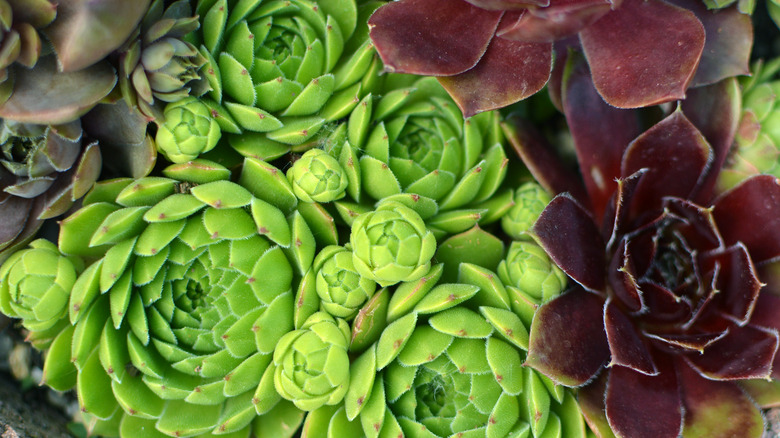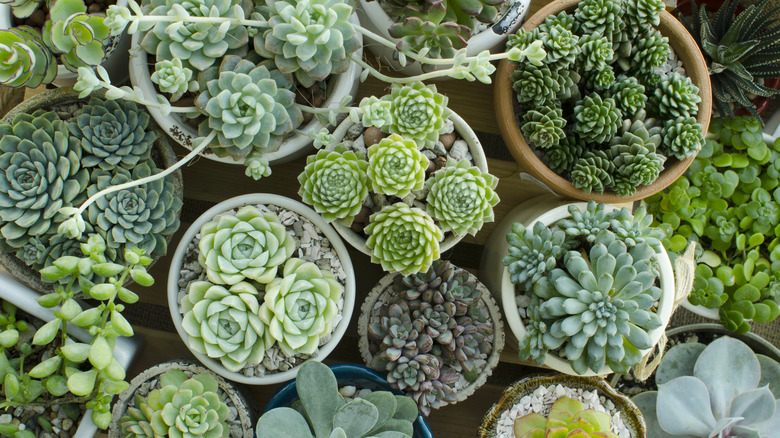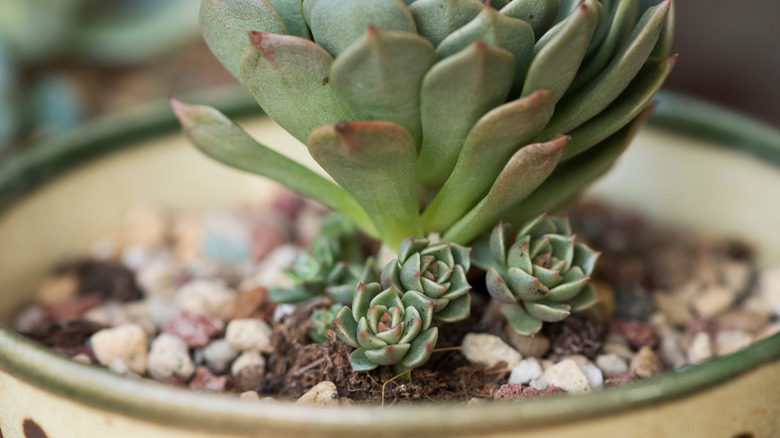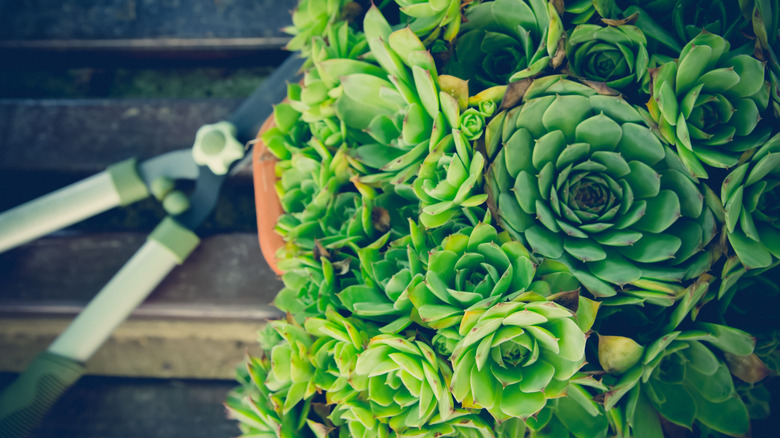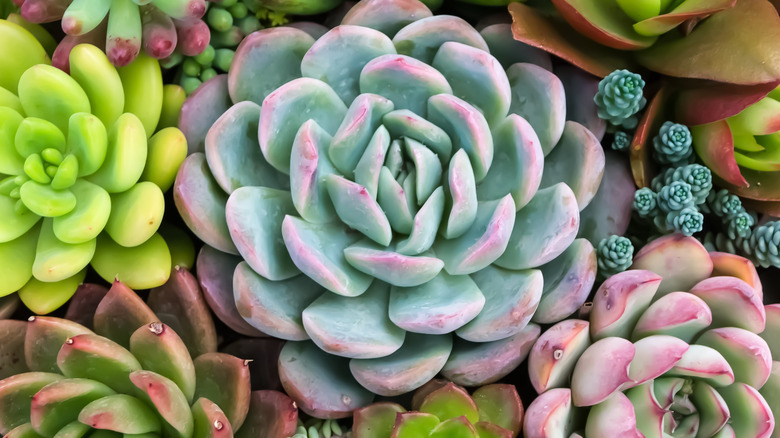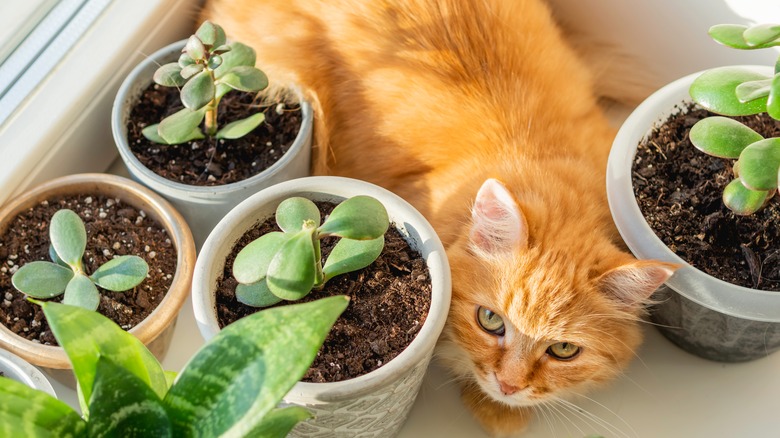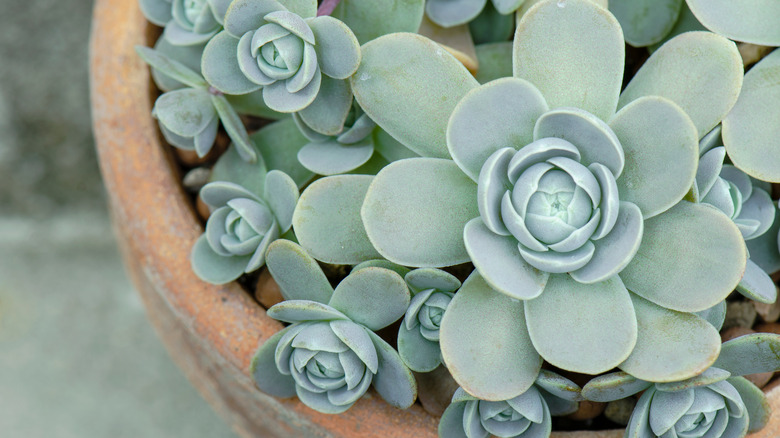How To Care For A Hens And Chicks Plant
What is a hen without her chicks? In the succulents group, hens and chicks is a ground-hugging evergreen plant with adorable character. Part of the flowering Crassulaceae (stonecrop) family, hens and chicks, or Sempervivum tectorum (Latin for "always living on roofs"), has many aliases', including "houseleeks," "hens and chickens," or "hen widdies," per Martha Stewart. The centralized "hen" plant sprouts surrounding offsets, or "chicks," which bloom into smaller rose-like plants called rosettes. Centuries-old, the eye-catching succulent is native to the areas of Europe and northern Africa (Morocco). According to World of Succulents, hens and chicks can be traced back to the ancient days of Charlemagne (742-814 A.D.). The Holy Roman Emperor requested his people to grow the houseplant on their rooftops for protection against fire and lightning.
Like a perfectly enticing confection, hens and chicks features several dense, flesh-like pointed leaves that store water, contributing to their heat and dryness resilience. The petals can grow up to 3 inches in diameter and have various blue, green, gold, pink, purple, or white colors. This perennial plant may grow 3-6 inches tall and 6-12 inches wide, per The Spruce. This alpine plant is deliciously attractive, but it is also highly drought-tolerant and low maintenance, known for its tolerance to poor soil conditions. As a result, the versatile hens and chicks remains a popular plant among garden enthusiasts indoors and out. Read on to learn how to care for a hens and chicks plant!
How to use hens and chicks in garden
Succulents come in various colors and sizes and are a decorative, whimsical addition to most any dry, sunny garden. From borders to planters and wall crevices, you can place hens and chicks in many different places, yet rock gardens are an ideal landscape for them. Here, the sun reflects off the rocks, giving the plant added heat, according to Plant Addicts. Hens and chicks is an underground runner, which creates an area of rosette clusters and can spread up to 2 feet or more in any direction, meaning you should give them enough room to grow when planting. Being drought-tolerant, they need more sun and less water, so it's good to keep them at a distance from other plants that may require more irrigation.
If planting in a rockery or rock garden, hens and chicks can be grown in your garden layout, close to sedum and rockcress, which are also drought-tolerant plants. Other companion plants with a wildflower appearance are yarrow and thrift because of their need for mat formations and drought tolerance, as per Better Homes & Gardens. Hens and chicks do well outside or inside. If planting in a pot, they prefer shallow and narrow containers with plenty of room to stretch. Place the container near a window, maintaining an indoor temperature of about 65 to 75 degrees Fahrenheit. If the temperature gets too cold or too hot, the plant may go dormant.
How to grow hens and chicks
Hens and chicks are particularly hardy succulents that thrive in plant hardiness zones 3 to 8. With a steady growth rate, they like neutral, well-draining, sandy or gravelly soil with full sun to light shade (up to six hours a day), per The Spruce. To plant it, mix some peat and sand into the blend to aid with ventilation and dig a hole just deep enough to secure the roots. Next, place the crown rosette in the ground so its base is level with the soil, and water a few days after the initial planting. The best time to plant it is in the spring after the last frost, per Plant Addicts.
The sturdy succulents do well in most pots, including driftwood, planters, or vertical planting walls. You can plant anytime for those potted indoors, but they will succeed before their growth spurt (September to November). If growing from a seed, sprinkle the seedlings onto a cactus mixture soil and mist the dirt evenly. Let the seeds germinate in a warm place for a while, then sprinkle a layer of fine gravel to sustain moisture. They are ready to transplant after you an inch of growth. To propagate hens and chicks, gently twist the leaves and let them rest until the ends appear callused; then, place them in a shallow pot or pan of soil and keep it moist by misting. When you see roots sprouting, transfer the plants into their new designated home.
How to care for hens and chicks
Because they are low maintenance, the main thing to focus on with hens and chicks plants is not to overwater them. Water thoroughly, but do it less often (when the soil appears dried out). If the leaves are soft or wilting, the main culprit is overwatering. Let a stream of water run to the plant rather than dumping it over the top. According to The Spruce, if the soil is drenched or has inadequate drainage, it can be a bed for a fungal activity or root rot. Additionally, while many plants may require fertilizer, hens and chicks do not. Able to thrive on mountainsides, rooftops, or crevices, they can survive in lesser terrain environments.
What about pests? Again, too much moisture is the enemy. Hens and chicks grown indoors, especially in greenhouses or other high moisture environments, often face severe conflicts with irritants like meal bugs and aphids. Try using an insecticide like neem oil or wipe out the invasion with rubbing alcohol by using a soaked cotton ball or swab, The Spruce recommends. But how long do hens and chicks last? According to Gardening Know How, when the succulents mature, a flower is produced but later detaches. Mother hen may also die off after a few years of life (approximately four to six) and should be removed. If the pot appears overcrowded, transfer the chicks to a new pot or location (every two years).
Varieties of hens and chicks
With thousands of colorful types to choose from, hens and chicks is dauntless enough to be grown most anywhere throughout the United States. Some are standard; others are new hybrids. Try browsing your local nursery or online store to find a particular one. Here are a few types to consider:
- Boissieri — This is a classic succulent that features red-tipped leaves with reddish-purple flowers and resides nicely in concrete planters at your doorstep, per Backyard Gardener. It might also be a lovely addition to window boxes.
- Sunset — This succulent is an extraordinary variety with emerald-green leaves and distinguished red tips with brilliantly green rosettes. Its foliage changes to an orangish-red with the crisp fall air.
- Oddity — This unique houseleek has curved, tubular green leaves with purple tips. It won the 1978 Bronze Rosette Award for the best new variety.
- Cobweb — A visibly interesting type because of the white threads that cover its center like a spider web, this plant appears green overall and is loved by growers for its distinctive texture.
- Gold Nugget — A Chick Charms brand of Sempervivum, this is a hardy, one-of-a-kind succulent that showcases a gold-tone with intense red and pink tips. This succulent was a Gold Medal winner as Best New Perennial for 2019 at the IPM Plant Show in Essen, Germany, AIPH writes.
Is hens and chicks toxic?
Although they look appetizing, hens and chicks can have a rather sour taste. If consumed, the toxicity level of the succulents is low for adults and children, but the leaves contain alkaloids, which are considered poisonous for short periods. The main concern is potential skin irritation from the sap present in the leaves, per Plant Addicts. This can cause temporary itching and burning, such as dermatitis. Although it's not fatal, it's not quite a delicacy either. Some people might include the thick leaves and young shoots into their diet, but it hasn't become a common delicacy.
This goes for animals and pets as well. According to the ASPCA (American Society for the Prevention of Cruelty to Animals), Sempervivum hens and chicks are not toxic to dogs, cats, or horses. Nevertheless, animals and pets should be safe with hens and chicks in your garden; however, you should still be careful, so they don't ingest large amounts of it.
How to repot hens and chicks
It may be time to repot your sempervivum when the roots and rosettes have outgrown their original space or if the mother is possibly starting to fade, but you can also do it in spring and summer during its growing season. Choose a container that is one size bigger and 1 or 2 inches wider than its original. It should be a well-draining, shallow container with some room to mature. According to The Spruce, a hypertufa pot or a stone container would be best. Clay or terracotta is not recommended, as these pot types could crack during the winter freezes. However, there is no need to move the plants inside for winter; they like the dry and cold hibernation period.
Furthermore, it's best to group your hens and chicks as one unit or with an array of other succulents. According to Youngs Garden Shop, you can revive your repotted colony with fresh compost, gravel, potting soil, sandy soil, or vermiculite. Whichever base you choose, they will be fine as they possess great survival skills compared to other plants. From there, water it sparingly.
